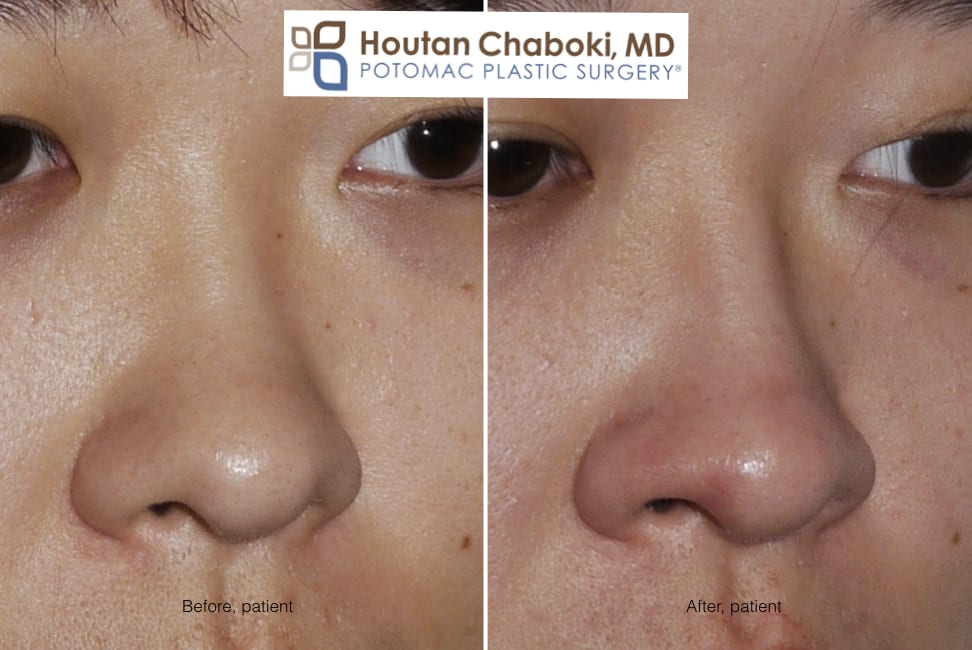
Augmentation rhinoplasty with layered, cartilage graft from the septum. The bridge or dorsum of the nose was enhanced to increase height, create definition, and provide illusion of bridge narrowing.
Rhinoplasty surgery is one of the most common cosmetic operations worldwide, especially for younger patients. Common rhinoplasty requests include reducing a bump, narrowing the tip, or lifting a droopy tip. Generally, many patients want smaller noses.
Rhinoplasty can achieve many goals, but the main rhinoplasty goal from a plastic surgeon’s perspective is to make a nose more proportionate and draw less attention. A balanced nose is preferred, and some patients can benefit from a larger nose.
Augmentation rhinoplasty involves increasing the size of the nose, primarily of the bridge or dorsum. Patients may complain the nose is too “flat” and has no structure. They want to improve the height of the nose. Patients may also report that they feel the bridge is too wide.
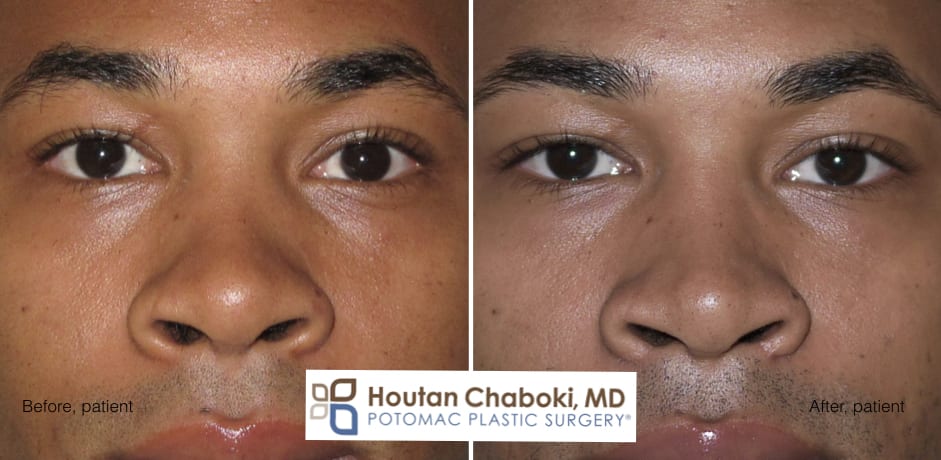
Augmentation rhinoplasty with cartilage graft from the septum. The bridge or dorsum of the nose was enhanced to increase height, create definition, and provide illusion of bridge narrowing.
Augmentation rhinoplasty is generally more common in Asian countries, such as China, Japan, Thailand, and Korea. Rhinoplasty to build the bridge in these countries is very popular and commonly performed with synthetic silicone implants.
Material to Augment the Nose
Building the bridge of the nose requires material to add volume. Many materials have been used over the years, but the three categories below are the common options. The best plastic surgeons will use a variety of materials and modify the procedure according the needs of each patient.
- cartilage – patient’s own (septum, ear, rib) or cadaveric (ex. irradiated rib, acellular dermis)
- synthetic solid implant – silicone, ePTFE (expanded polytetrafluoroethylene, Gore-Tex®)
- synthetic gel implant – filler injections (hyaluronic acid, Restylane®)
Plastic surgeons (and patients) generally prefer natural results and use the patient’s own cartilage when possible. Cartilage is taken from inside the nose during septoplasty, the ear, or the rib. Each of these cartilage grafts have their own advantages and disadvantages. Dr. Chaboki, a cosmetic surgery specialist, often uses nasal cartilage to build the bridge, thus avoiding a separate scar from getting cartilage from another body part.
Silicone nasal implants come pre-formed in various shapes and sizes, and may be sculpted as necessary by your plastic surgeon. The two common shapes are the L-shape (augments bridge and tip) and the I-shape or dorsal-shape (augments bridge only). One reason silicone is a popular solid implant is that it’s very easy to place and remove, if needed. However, a disadvantage of silicone is that the implant may become visible and is at risk of scar capsule formation, infection, or extrusion.
Similar to silicone, ePTFE is used for a variety of medical procedures, including cosmetic surgery. Unlike silicone, ePTFE has small pores that allow for tissue ingrowth without forming typical scar tissue capsule. The material is permanent and does not degrade after implantation. Unlike silicone, ePTFE is not known to extrude from the nose. However, this implant also has risk of infection and is very difficult to remove, if needed.
The newest materials available for dorsal augmentation rhinoplasty are the synthetic gels made of hyaluronic acid (Restylane® and Belotero®). Plastic surgeons have been using the gel injections for years to treat wrinkles, plump lips, and enhance cheeks, but more recently have been using it the nose for nonsurgical rhinoplasty. Read more about this nonsurgical liquid lift of the nose.
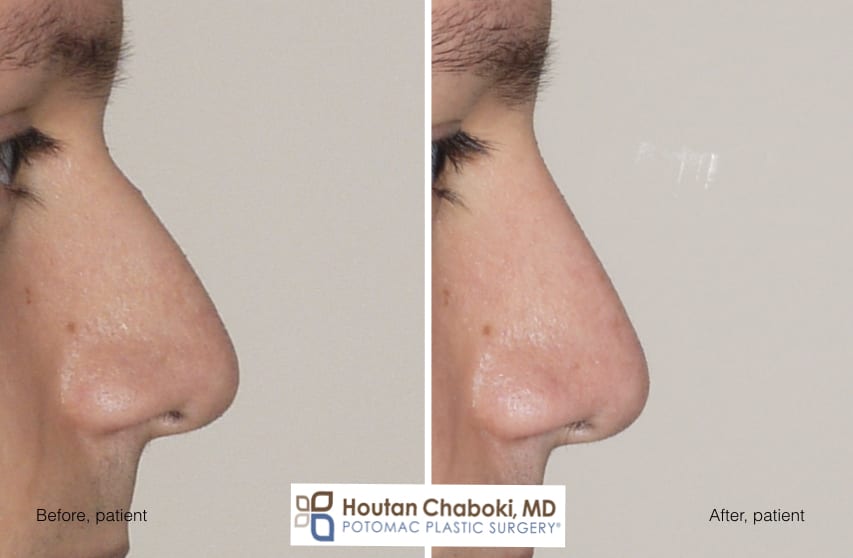
Nonsurgical rhinoplasty to augment the nose with Restylane® injection. The profile was improved without surgery in a quick office procedure.
Rhinoplasty Method to Augment the Nose
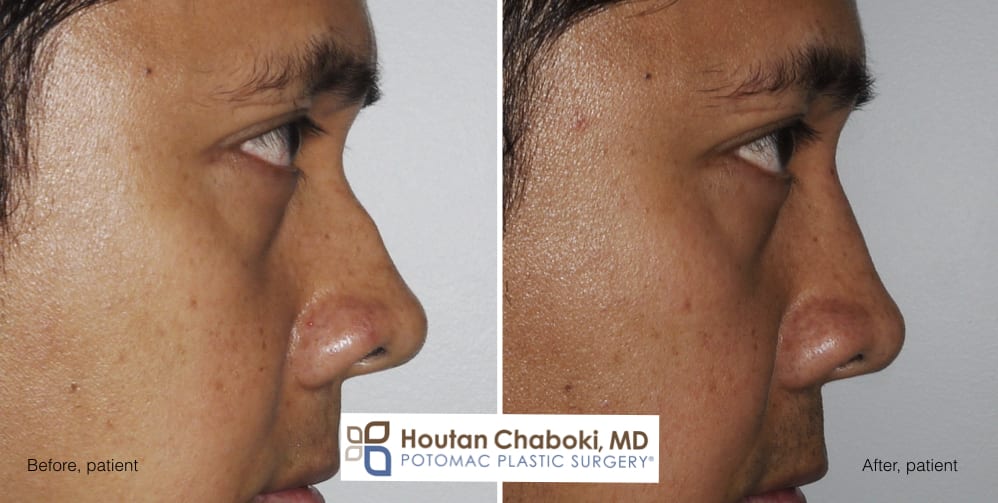
Augmentation rhinoplasty with cartilage graft from the septum. The bridge or dorsum of the nose was enhanced to increase height and improve the profile.
Rhinoplasty may be performed via an open (external scar) or closed (no external scar) approach to augment the bridge. Top plastic surgeons use a variety of methods of rhinoplasty and typically tailor the procedure to the needs of each patient. Regardless of material, the implant is placed ontop of the skeletal bridge and cartilage of the nasal bridge. All the surgical rhinoplasty cases on this page have been performed via a closed approach by Dr. Chaboki, a rhinoplasty specialist.
Dorsal augmentation not only improves the flat appearance of the nose by increasing height, but also may create the illusion of bridge narrowing without breaking the nasal bones. Typical wide nasal bridges often require breaking the nose to push the nasal bones together. However, a nose can also appear narrower on front view simply by augmentation of the bridge.
Cartilage grafts may be placed as a single piece or layered (stacked) ontop of each other for further augmentation. Lastly, cartilage may be diced or cut into small pieces, then wrapped inside a membrane. This “diced cartilage in fascia” is another commonly used method in augmentation rhinoplasty.
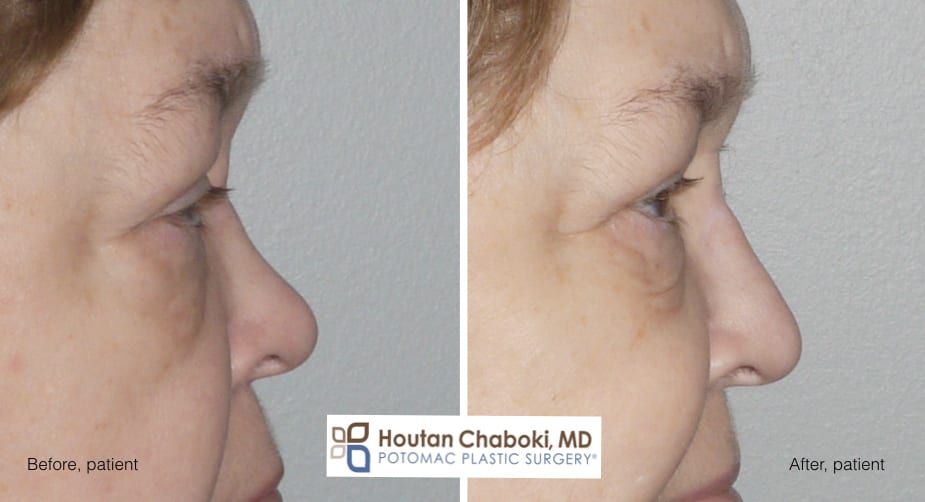
Augmentation rhinoplasty with diced cartilage graft from the ear. The bridge or dorsum of the nose was enhanced to increase height and improve the profile.
What is the Best Augmentation Rhinoplasty Method?
An evaluation by a cosmetic surgeon who specializes in a variety of nose procedures can help you determine what is the “best” procedure for you. Your specific anatomy (i.e. cartilage, skin, bone, etc), along with recovery time, budget, and medical history are some of the factors that can affect the decision between you and your plastic surgeon.
Patients appreciate Dr. Chaboki’s conservative approach and have put trust in his expert opinion. Learn more about rhinoplasty in our blog. Contact the office to schedule a consultation.

I had a rhinoplasty the M.D. had broken my nose ,My nose was flat,wide and had a small bulbous tip.My nose is even bigger then before! I ask him 2 use my septum cartilage and nothing else.He also said he did an alarplasty no changes nostrils are still wide.
Thank you for reading the blog.
Rhinoplasty to build the bridge more often does not require breaking the nose, as the plastic surgeon is adding material onto of the bridge. Noses that appear bigger after rhinoplasty may be due to swelling, which is expected after any surgery. Read more about swelling after plastic surgery and rhinoplasty swelling in our blog.
Best,
Dr. Chaboki
Revision rhinoplasty inquiry
Thank you for reading our blog! We’re open for virtual consultation at this time. Please call the office 202-800-2085 to review revision rhinoplasty.
Can you do cartilage injection to both sides to rewiden nose from unwanted narrowing and collapse? Do not want to undergo major revision. Thank you in advance.
Hi,
Cartilage injection is an option. An alternative injection is fillers to help widen a nose from prior rhinoplasty. A consultation would be required to help determine possible options. Please contact the office to get started. Thank you!
Thank You for this blog
You’re welcome. Thank you for reading and your support!
Can the nasal bones be rewidened if lateral osteotomy was performed? Nose looks too narrow now and doesnt suit my face. How about making nostrils wider as well?
Thank for you reading the blog!
Plastic surgeons generally advise that it’s harder to widen the nose than to make it narrow. Patients should speak with a rhinoplasty surgeon to help determine appropriate treatment options.
Best,
Dr. Chaboki